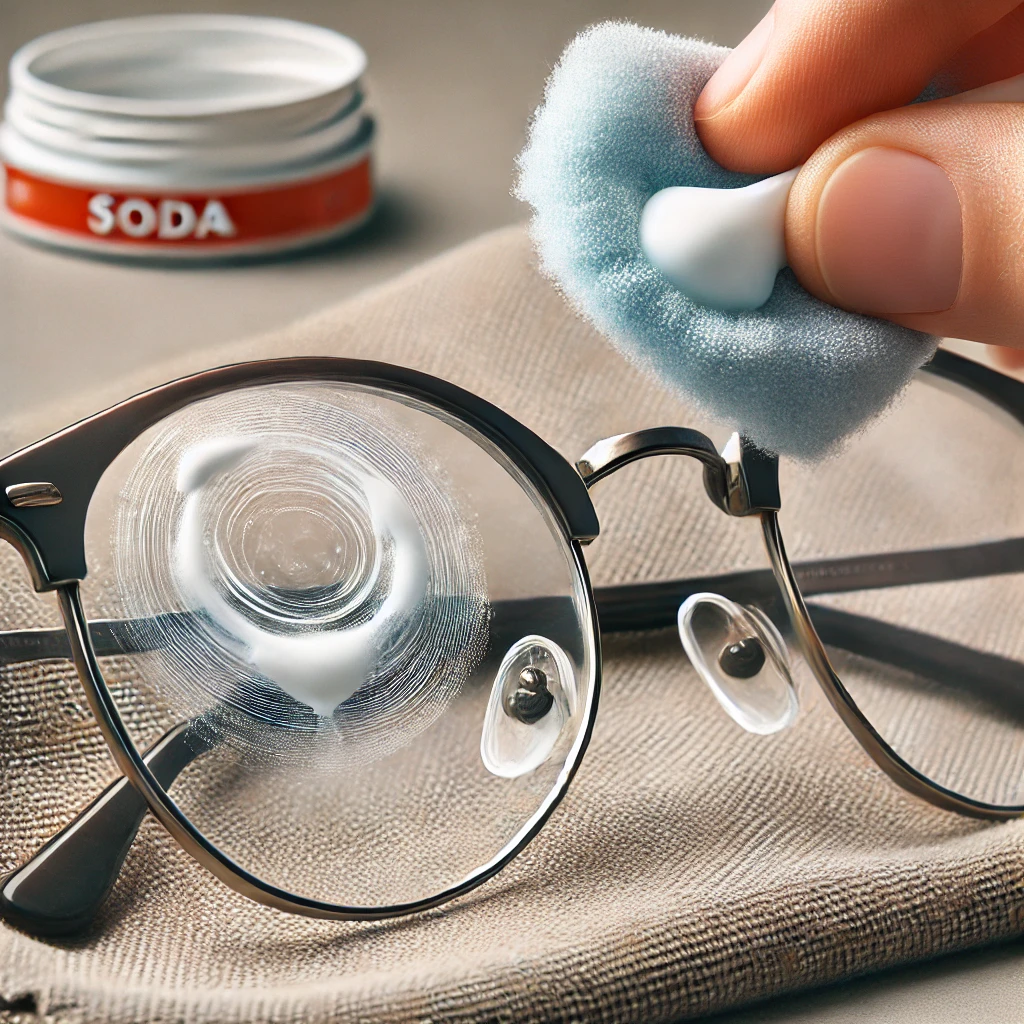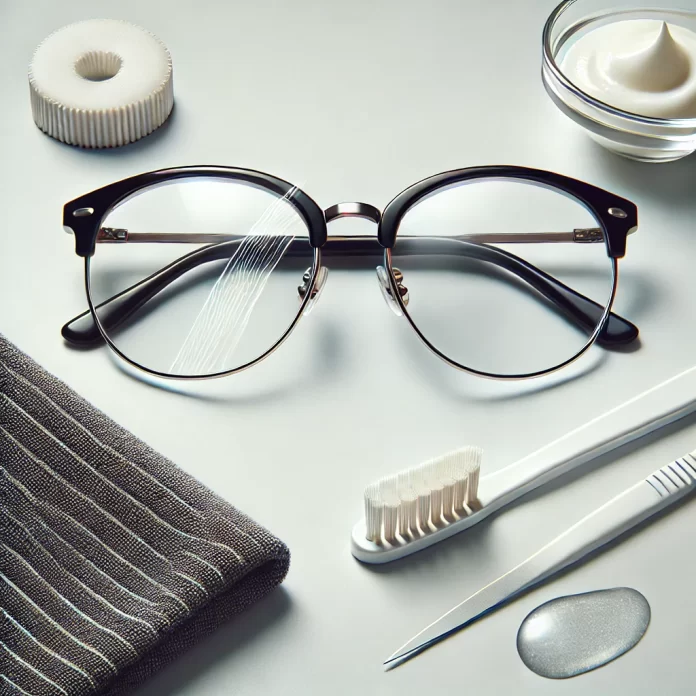Summary
If you are one of these people who always wear glasses and then you have scratched your eyeglasses, which is such and such, then you have experienced what a common problem that is. Lenses are not an exception to the rule, and no matter if you’re wearing them or not, blue light glasses or sunglasses – scratched lenses are just freaking annoying. And so I’m writing to you to teach you how to use toothpaste & baking soda to treat a glass scratch from the comfort of your home and to prevent scratches.Read this guide to learn how to heal simple scratches on your glasses. Learn when it’s time to replace your contact case if scratches are affecting your vision.
1. What Causes Scratches on Glasses Lenses?
Your glasses can have scratches for all sorts of reasons. If you do not take care of plastic/lenses made of polysilicon and plastic, polycarbonate, or glass, they will scratch over time.
Many delicate causes result from dropped glass and the use of harsh cleaning agents or rough cleaning cloths. Using the wrong cleaning thing for your glasses is another common offender.A microfiber cloth is your best option, but avoid anything that could damage the lens coating, like a rough towel or cloth that could scratch your glasses. Improper use might scratch your eyeglass lenses, and dust and dirt may scratch them.2. Can Scratches on Glasses Be Removed?
Generally speaking, you can buff out minor scratches and forget the embarrassment. However, you will have to regear and possibly replace a new lens for deep scratches. Then, there were techniques for buffing scratch marks out of the lens surface, such as toothpaste or baking soda paste. However, remember that even in this case, these methods are not very useful to combat minor scratches and may not be useful for combating deep scratches as well. Search about how to get deep scratches out of glasses
You should typically replace more complex lenses like scratch resistant lenses further down the list (unless you take proper steps in attempting to remove the scratches yourself), as they are much harder to repair and can often worsen the problems. But here are home remedies for prescription glasses, sunglasses or blue light glasses to remove scratches.
3. Why Using Toothpaste for Scratches on Glasses Works
This is why toothpaste — which sounds easy and for many, can be effective to get the scratch off the glass — has abrasives (strong enough to do a few scratches to the head but not enough to damage the glass), and toothpaste is a known and suggested method. Despite this, if you apply it to a scratched lens in a circular motion with a soft cloth, you can remove the appearance of these scratches on the scratched lens.This article is fully related to how to get scratch out of glasses. When using toothpaste to rub lenses, avoid gel-based toothpaste. Gel toothpaste doesn’t contain the abrasive particles needed for scrubbing, so it won’t be effective. Then you take the rubber side of the lens, rub toothpaste on the lens (where the scratch is), in small circular movements and rinse off with water so the solution comes out.
4. How to Remove Scratches from Glasses at Home with Baking Soda
The home remedy for cleaning glass scratches is baking soda, too. Scratches can be buffed out using it; it’s a really mild abrasion, kind of like toothpaste. One part baking soda with two parts water mixed makes baking soda paste. With a soft cloth, gently rub the mixture over the scratched lens using circular motions. Rinse the lens with water and dry it thoroughly with a microfiber cloth to prevent further scratches. Microfiber cloths work best for minor scratches or shallow scuffs, but deep scratches may require professional repair or lens replacement.
5. Should You Fix Scratches on Your Glasses or Replace the Lenses?
There are ways to remove minor scratches at home, but you should replace the lenses altogether sometimes. If there are scratches that are so deep that you can see them, or if there’s some sort of damage that affects the way your eyes work, you probably need new glasses or new lenses.
Experts say that heavy scratches on lenses can compromise coatings designed to reduce glare or block blue light, making them less effective. In some cases, scratched lenses can cause eye strain if they are not replaced. If the cost of fixing or replacing your scratched lenses is less than buying new ones, it might be worth either fixing them or simply buying new ones. An optometrist or lens repair professional can help you visit.
6. How to Prevent Scratches on Your Glasses
First is proper care in preventing scratches on your glasses. The best way to keep your glasses scratched-free is always to store them in a glasses case when you’re not wearing them. Don’t just plop your glasses lens side down on any old surface; you can easily carry scratches.
Use a microfiber cloth to clean your lenses instead of paper towels or clothing to prevent damaging them. Keep your glasses safe and ensure they do not get scratched when you put them down. Most glasses these days have a scratch-resistant coating for added protection.
7. Are There Scratch-Resistant Coatings for Glasses?
We will apply a scratch-resistant coating to the lenses and bake them to provide protection against daily wear and tear. While these coatings aren’t permanent, they do help shield your glasses from most scuffs and scratches. It’s important to maintain this coating over time. Some types of ink won’t scratch the lenses, even if they come into contact with them, while others can scratch and gradually wear down the coating.
If your glasses have a scratch, look into those that have a scratch-resistant coating. That’s the best. It’s not scratchproof, but it will give you the natural life of the lenses many times and will save you from having all sorts of replacements.
8. Using Glass Etching Cream for Deep Scratches
For severe scratches, the last resort is glass etching cream. It comprises fine chemicals that cause wear down the lens surface dis, solve the top layer of the lens, and remove scratches. Please don’t use it on lenses with coatings, with or without Focals lenses.
This method can remove deep scratches that toothpaste or baking soda cannot fix, but it should only be used on non-coated lenses.
9. How to Clean Your Glasses Correctly to Avoid Scratches
If you clean your glasses wrong, they’ll scratch. Always rinse your glasses with water first. Then blow them dry before wiping with a microfiber cloth. Never rub debris into the lens surface. Avoid using household cleaners, oils, paper towels, or tissues on your glasses. They would scratch it. This is how to get the scratches out of glasses
The simplest way to keep lenses clean and scratch-free is to remove the lenses and use a lens-specific cleaning solution and a micro flex cloth. Try to get glasses of your treatment to work along for a long time, treat your glasses, and clean them up.

10. Should You Consider Wearing Contact Lenses to Avoid Scratches?
If all you want is scratched glasses, contact lenses are an option. If you wear contact lenses daily, they can be a great alternative to glasses. Contact lenses don’t require the same level of maintenance, and you won’t have to worry about scratches like you would with glasses. If scratched glasses are driving you crazy, switching to contacts might be a good solution.
However, if you’re already using part-time or full-time contacts, you may want to stick with that option. Just remember, contact lenses still require careful handling, as improper care can lead to eye infections.
Bullet Point Summary of Most Important Things to Remember
- Most minor scratches can be rubbed out with toothpaste or baking soda from the comforts of your own home.
- Severe scratches that appear in the working zone mean the need for professional services or the addition of new lenses.
- To prevent scratching, always place your glasses in a case when they are not in use.
Warning: Never use paper towels or any other rough material to clean your glasses, and remember to use a microfiber cloth. - Very smooth glasses may be slippery, so preference is given to glasses with a scratch-resistant coating.
- The deep scratches can be treated with the help of glass etching cream but the application of this product has to be very cautious.
- Another option for people who do not like the idea of wearing scratched glasses is contact lenses.
FAQ
1. Can I really remove scratches from glasses at home?
Absolutely! However, it is, in most cases, impossible to repair scratches at home. Most minor scratches can quickly be dealt with. Nevertheless, all these working mechanisms are only suitable for wiping minor scratches on glasses but not gouged ones. Here, one should start with the very gentle and least dangerous approach to the glasses’ lenses evermore. Always remember, if you have office or prescription glasses, or expensive frames, it’s best to consult a professional if you’re unsure about how to proceed with DIY scratch repair.
2. What’s the easiest method to get scratches out of glasses?
Earlier mentioned are some of the easiest methods of treating scratched glasses, and they include the use of toothpaste. To remove scratches from the lenses, apply non-gel white toothpaste to a microfiber cloth. Rub the toothpaste in circular motions over the scratched area of the lenses. This should take about ten seconds, then rinse in cool water and wipe off clean. This method goes a long way in eliminating any scratches on glass lenses, including blue light glasses. Just don’t put too much emphasis on it, and remember, be very careful not to scrape off the lens coating.
3. I’ve heard about using baking soda to fix scratches on glasses. How does that work?
Another method of how to deal with scratches on the eyeglass lenses is using baking soda. As I mentioned, if you remember one key instruction, it’s to mix water with baking soda until you form a thick paste. Apply the paste to the scratched lens surface. Wipe in circular motions using a soft, clean cloth for about 20 seconds. Afterward, rinse with cold water and dry with a microfiber cloth.


